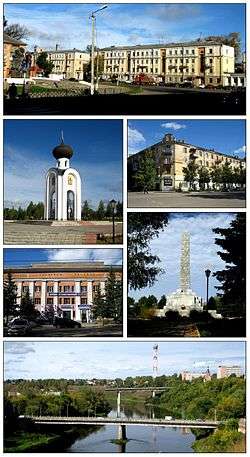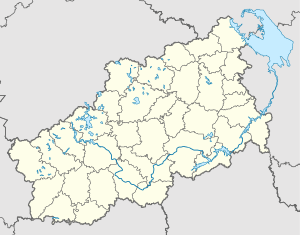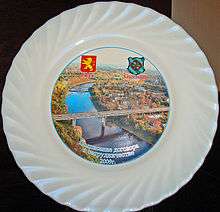Rzhev
| Rzhev (English) Ржев (Russian) | |
|---|---|
|
- Town[1] - Town of oblast significance[1] | |
 Views of Rzhev | |
.svg.png) Location of Tver Oblast in Russia | |
 Rzhev | |
|
| |
 |
|
|
| |
| Administrative status (as of December 2012) | |
| Country | Russia |
| Federal subject | Tver Oblast[1] |
| Administratively subordinated to | Rzhev Okrug[1] |
| Administrative center of | Rzhevsky District,[2] Rzhev Okrug[1] |
| Municipal status (as of September 2006) | |
| Urban okrug | Rzhev Urban Okrug[3] |
| Administrative center of | Rzhev Urban Okrug,[3] Rzhevsky Municipal District[3] |
| Head of Administration | Alexander Shcheteshin |
| Statistics | |
| Population (2010 Census) | 61,982 inhabitants[4] |
| - Rank in 2010 | 257th |
| Time zone | MSK (UTC+03:00)[5] |
| First mentioned | 1216 |
| Postal code(s)[6] | 172380 |
| Dialing code(s) | +7 48232 |
|
| |
| Rzhev on Wikimedia Commons | |
Rzhev (Russian: Ржев; IPA: [ˈrʐɛf]) is a town in Tver Oblast, Russia, located 49 kilometers (30 mi) southwest of Staritsa and 126 kilometers (78 mi) from Tver, on the highway and railway connecting Moscow and Riga. It is the uppermost town situated on the Volga River. Population: 61,982 (2010 Census);[4] 63,729 (2002 Census);[7] 69,808 (1989 Census).[8]
History

Rzhev was founded in the Middle Ages and rivals Toropets as the oldest town in the region. Rzhevians usually point out that their town is mentioned in the Novgorod laws as early as 1019. Their neighbors from Toropets, on the other hand, give more credence to Rzhev's first mention in a major chronicle under 1216, when it was in possession of Mstislav the Bold, Prince of Toropets. Whatever the truth may be, it is clear that medieval Rzhev was bitterly contested by three regional powers—the Novgorod Republic, the Principality of Smolensk, and the Grand Principality of Vladimir-Suzdal. Following the Mongol invasion, Rzhev passed to a lateral branch of the Smolensk dynasty, which made the town its capital. Later the princes divided the town in two parts, which are still called the Prince-Dmitry's Side and Prince-Theodor's Side. In the mid-14th century, they had a hard time repelling attacks from Algirdas of Lithuania and Grand Princes of Tver, who bought all the villages around the town. Finally, they left for Moscow, where their descendants (the Rzhevsky family) have become comic characters of many a joke. In the meantime, the town was occupied for a short space by Tver, Poland-Lithuania, and finally by the Grand Duchy of Moscow.[9]
In the course of the administrative reform carried out in 1708 by Peter the Great, Rzhev was included into Ingermanlandia Governorate (since 1710 known as Saint Petersburg Governorate), and in 1727 Novgorod Governorate split off. In 1775, Tver Viceroyalty was formed from the lands which previously belonged to Moscow and Novgorod Governorates, and Rzhev was transferred to Tver Viceroyalty, which in 1796 was transformed to Tver Governorate. In 1775, Rzhevsky Uyezd was established, with the center in Rzhev.[10] In the 18th century, local merchants, mainly of Old Believer confession, brought a great measure of prosperity to the town.
On 12 July 1929, governorates and uyezds were abolished, and Rzhevsky District with the administrative center in the town of Rzhev was established. It belonged to Rzhev Okrug of Western Oblast.[11][12] On August 1, 1930 the okrugs were abolished, and the districts were subordinated directly to the oblast. On 29 January 1935 Kalinin Oblast was established, and Rzhev was transferred to Kalinin Oblast.[10][11] In 1990, Kalinin Oblast was renamed Tver Oblast.[12]
During World War II, Rzhev was occupied by German troops from 14 October 1941 to 3 March 1943. More than one-sixth of the population was sent off to forced labor in Germany during the Nazi occupation and some nine thousand residents were shot, starved, or tortured to death in a concentration camp set up in the center of town. During this occupation, the general area of Rzhev, Sychyovka and Vyazma was the site of a set of major military operations between the Red Army and Nazi German military forces. These operations, which resulted in a great loss of civilian and military life, are commonly referred to as the Battles of Rzhev and almost completely wiped out the population of the town. Almost no old architecture survived these battles.
Administrative and municipal status
Within the framework of administrative divisions, Rzhev serves as the administrative center of Rzhevsky District,[2] even though it is not a part of it.[1] As an administrative division, it is incorporated separately as Rzhev Okrug—an administrative unit with the status equal to that of the districts.[1] As a municipal division, Rzhev Okrug is incorporated as Rzhev Urban Okrug.[3]
Economy
Rzhev produces most of the cranes used in constructing apartment buildings and shopping malls in Moscow.
Transportation
The railway which connects Moscow and Riga runs through Rzhev. Another railway connecting Torzhok with Vyazma via Rzhev, crosses it from north to south. There is passenger railway traffic.
The M9 highway connecting Moscow with Riga also passes Rzhev. Two other roads connect Rzhev with Tver via Staritsa and with Ostashkov via Selizharovo. There are also local roads with bus traffic originating from Rzhev.
The Volga is navigable, however, there is no passenger navigation.
Military
It was home to the Rzhev and Bakhmutovo air bases during the Cold War.
Culture and recreation
Rzhev contains 15 cultural heritage monuments of federal significance and additionally 72 objects classified as cultural and historical heritage of local significance. The federal monuments include the Church of John the Baptist (also known as the Okovtsy Church) built in the 19th century, monuments to soldiers and civilians fallen in World War II, as well as a number of archeological sites.[13]
There is a local museum in Rzhev.[14] As a highly controversial move, in 2013 Joseph Stalin Museum was open in a building where Joseph Stalin spent one night in 1943 while inspecting the troops. As of 2015, the museum did not have regular opening hours and was only open by appointment, trying to keep a low profile.[15]
International relations
Twin towns and sister cities
Rzhev is twinned with:
 Katrineholm, Sweden[16]
Katrineholm, Sweden[16] Salo, Finland
Salo, Finland Legionowo, Poland
Legionowo, Poland Kovel, Ukraine
Kovel, Ukraine Silistra, Bulgaria
Silistra, Bulgaria Gütersloh, Germany
Gütersloh, Germany
References


Notes
- 1 2 3 4 5 6 7 Law #34-ZO
- 1 2 Государственный комитет Российской Федерации по статистике. Комитет Российской Федерации по стандартизации, метрологии и сертификации. №ОК 019-95 1 января 1997 г. «Общероссийский классификатор объектов административно-территориального деления. Код 28 248», в ред. изменения №259/2014 от 12 декабря 2014 г.. (State Statistics Committee of the Russian Federation. Committee of the Russian Federation on Standardization, Metrology, and Certification. #OK 019-95 January 1, 1997 Russian Classification of Objects of Administrative Division . Code 28 248, as amended by the Amendment #259/2014 of December 12, 2014. ).
- 1 2 3 4 Law #4-ZO
- 1 2 Russian Federal State Statistics Service (2011). "Всероссийская перепись населения 2010 года. Том 1" [2010 All-Russian Population Census, vol. 1]. Всероссийская перепись населения 2010 года (2010 All-Russia Population Census) (in Russian). Federal State Statistics Service. Retrieved June 29, 2012.
- ↑ Правительство Российской Федерации. Федеральный закон №107-ФЗ от 3 июня 2011 г. «Об исчислении времени», в ред. Федерального закона №271-ФЗ от 03 июля 2016 г. «О внесении изменений в Федеральный закон "Об исчислении времени"». Вступил в силу по истечении шестидесяти дней после дня официального опубликования (6 августа 2011 г.). Опубликован: "Российская газета", №120, 6 июня 2011 г. (Government of the Russian Federation. Federal Law #107-FZ of June 31, 2011 On Calculating Time, as amended by the Federal Law #271-FZ of July 03, 2016 On Amending Federal Law "On Calculating Time". Effective as of after sixty days following the day of the official publication.).
- ↑ Почта России. Информационно-вычислительный центр ОАСУ РПО. (Russian Post). Поиск объектов почтовой связи (Postal Objects Search) (Russian)
- ↑ Russian Federal State Statistics Service (May 21, 2004). "Численность населения России, субъектов Российской Федерации в составе федеральных округов, районов, городских поселений, сельских населённых пунктов – районных центров и сельских населённых пунктов с населением 3 тысячи и более человек" [Population of Russia, Its Federal Districts, Federal Subjects, Districts, Urban Localities, Rural Localities—Administrative Centers, and Rural Localities with Population of Over 3,000] (XLS). Всероссийская перепись населения 2002 года [All-Russia Population Census of 2002] (in Russian). Retrieved August 9, 2014.
- ↑ Demoscope Weekly (1989). "Всесоюзная перепись населения 1989 г. Численность наличного населения союзных и автономных республик, автономных областей и округов, краёв, областей, районов, городских поселений и сёл-райцентров" [All Union Population Census of 1989: Present Population of Union and Autonomous Republics, Autonomous Oblasts and Okrugs, Krais, Oblasts, Districts, Urban Settlements, and Villages Serving as District Administrative Centers]. Всесоюзная перепись населения 1989 года [All-Union Population Census of 1989] (in Russian). Институт демографии Национального исследовательского университета: Высшая школа экономики [Institute of Demography at the National Research University: Higher School of Economics]. Retrieved August 9, 2014.
- ↑ Янин, В.Л. (1998). "Новгород и Литва: Пограничные ситуации XIII-XV веков" (in Russian). Moscow State University. Retrieved 29 May 2015.
- 1 2 Справка об изменениях в административно-территориальном делении Тверской губернии - Калининской области (in Russian). Архивы России. Retrieved 1 March 2014.
- 1 2 Воробьёв, М. В. (1993). Г. В. Туфанова, ed. Административно-территориальное деление Смоленской области (in Russian). Государственный архив Смоленской области. pp. 118–133.
- 1 2 Малыгин, П. Д.; Смирнов, С. Н. (2007). История административно-территориального деления Тверской Области (PDF). Tver. pp. 14–15. OCLC 540329541.
- ↑ Памятники истории и культуры народов Российской Федерации (in Russian). Russian Ministry of Culture. Retrieved 2 June 2016.
- ↑ Ржевский краеведческий музей (in Russian). Российская сеть культурного наследия. Retrieved 14 June 2015.
- ↑ Kots, Alexander; Dmitry Steshin (10 June 2015). Во Ржеве хотят, но боятся открыть музей-избушку Сталина (in Russian). Komsomolskaya Pravda. Retrieved 14 June 2015.
- ↑ A seed has been sown for Safe Communities in Russia the future will show how it grows
Sources
- Законодательное Собрание Тверской области. Закон №34-ЗО от 17 апреля 2006 г. «Об административно-территориальном устройстве Тверской области», в ред. Закона №66-ЗО от 1 октября 2014 г. «О внесении изменения в статью 18 Закона Тверской области "Об административно-территориальном устройстве Тверской области"». Вступил в силу со дня официального опубликования. Опубликован: "Тверские ведомости", №17 (специальный выпуск), 19 апреля 2006 г. (Legislative Assembly of Tver Oblast. Law #34-ZO of April 17, 2006 On the Administrative-Territorial Structure of Tver Oblast, as amended by the Law #66-ZO of October 1, 2014 On Amending Article 18 of the Law of Tver Oblast "On the Administrative-Territorial Structure of Tver Oblast". Effective as of the official publication date.).
- Законодательное Собрание Тверской области. Закон №4-ЗО от 18 января 2005 г. «Об установлении границ муниципальных образований Тверской области и наделении их статусом городских округов, муниципальных районов», в ред. Закона №65-ЗО от 24 июля 2012 г. «О внесении изменения в статью 2 Закона Тверской области "Об установлении границ муниципальных образований Тверской области и наделении их статусом городских округов, муниципальных районов"». Вступил в силу через десять дней после официального опубликования. Опубликован: "Тверские ведомости", №3, 21–27 января 2005 г. (Legislative Assembly of Tver Oblast. Law #4-ZO of January 18, 2005 On Establishing the Borders of the Municipal Formations of Tver Oblast and on Granting Them the Status of Urban Okrugs, Municipal Districts, as amended by the Law #65-ZO of July 24, 2012 On Amending Article 2 of the Law of Tver Oblast "On Establishing the Borders of the Municipal Formations of Tver Oblast and on Granting Them the Status of Urban Okrugs, Municipal Districts". Effective as of the day which is ten days after the official publication.).
